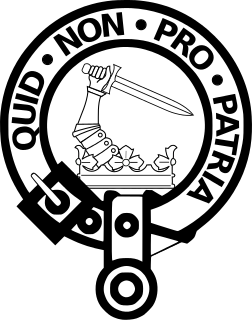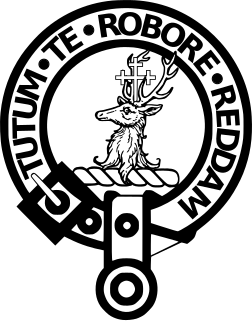Related Research Articles
Donnchad mac Máel Coluim was king of Scots. He was son of Malcolm III and his first wife Ingibiorg Finnsdottir, widow of Thorfinn Sigurdsson.
Cináed mac Duib, anglicised as Kenneth III, and nicknamed An Donn, "the Chief" or "the Brown", was King of Scots from 997 to 1005. He was the son of Dub. Many of the Scots sources refer to him as Giric son of Kenneth son of Dub, which is taken to be an error. An alternate explanation is that Kenneth had a son, Giric, who ruled jointly with his father.

Urquhart is a Highland Scottish clan.

Clan Sutherland is a Highland Scottish clan whose traditional territory is the shire of Sutherland in the far north of Scotland. The chief of the clan was also the powerful Earl of Sutherland, however in the early 16th century this title passed through marriage to a younger son of the chief of Clan Gordon. The current chief is Alistair Sutherland who holds the title Earl of Sutherland.

Clan crest: Sunflower turning to the sun

Clan Drummond is a Highland Scottish clan. The surname is rendered "Druimeanach" in modern Scottish Gaelic.

Clan Buchanan is a Highlands Scottish Clan whose origins are said to lie in the 1225 grant of lands on the eastern shore of Loch Lomond to clergyman Sir Absalon of Buchanan by the Earl of Lennox.
The personal name Duncan can be found in Scotland’s oldest records in its Gaelic form Dunchad/Donchadh/Donachie/Donnchadh and other spelling variants.

Clan Dewar is a Scottish clan.

Clan MacLaren is a Highland Scottish clan. Traditional clan lands include the old parish of Balquhidder which includes the villages of Lochearnhead and Strathyre, and is about 18 miles (29 km) long and 7 miles (11 km) broad, spanning 54,675 acres (22,126 ha), long known as "Maclaren Country".

The Clan Malcolm, also known as the Clan MacCallum, is a Highland Scottish clan. The Clan MacCallum may have originally been a separate clan until the 18th century, when the chief of the Clan MacCallum adopted the name Malcolm after inheriting the Malcolm estate, and the two clans were drawn together under the same chief.

Clan MacAulay, also spelt Macaulay or Macauley is a Scottish clan. The clan was historically centred on the lands of Ardincaple, which are today consumed by the little village of Rhu and burgh of Helensburgh in Argyll and Bute. The MacAulays of Ardincaple were located mainly in the traditional county of Dunbartonshire, which straddles the "Highland Line" between the Scottish Highlands and Lowlands. Clan MacAulay has been considered a "Highland clan" by writers and has been linked by various historians to the original Earls of Lennox and in later times to Clan Gregor. The MacAulays of Ardincaple, like Clan Gregor and several other clans, have traditionally been considered one of the seven clans which make up Siol Alpin. This group of clans were said to have claimed descent from Cináed mac Ailpín, King of the Picts, from whom later kings of Scotland traced their descent. The chiefs of Clan MacAulay were styled Laird of Ardincaple.

MacShane is a patronymic surname originating in Ireland. The surname evolved from the given name Shane, a derivative of John, of Hebrew origin. Early records spelled the name Mac Seáin or Mac Seagháin. Historically, the MacShanes from Ulster are a branch of the O'Neills, while in County Kerry, the surname was adopted by the Fitzmaurices. MacShane is uncommon as a given name.

Clan Crawford is a Scottish clan of the Scottish Lowlands. The clan is of Scandinavian and Anglo-Saxon origin. Since the early 18th century an erroneous belief was held by some historians that the clan had Norman origins, but this belief has been shown to be false and based on spurious comparisons of the arms of Crawford with those of the Earl of Richmond. While historically recognised as a clan by the Court of the Lord Lyon, it is now an armigerous clan as it no longer has a chief. The last chief was Hugh Ronald George Craufurd, who sold his land and moved to Canada in 1904. He died in Calgary in 1942, leaving no male heirs.

Clairinsh or Clairinch is an island in Loch Lomond, central Scotland.

"Major" John Buchanan was an American frontiersman and one of the founders of present-day Nashville, Tennessee. He is best known for defending his fort, Buchanan Station, from an attack by several hundred Native American Indians on September 30, 1792. The defense at Buchanan's Station saved early Nashville, which was unprepared after dismissing rumors of an incoming Indian onslaught. On their part, the Indians recoiled, splitting into small parties that caused considerable damage to outlying homesteads but abandoned the major attack on Nashville. Nor was any like invasion attempted again. The defense of Buchanan's Station not only spared Nashville, but raised the morale of the pioneers at a dark and difficult time, and was frequently recalled in the following decades as a symbol of the courage and determination of the founders of the state of Tennessee.

Clan Fleming is a Scottish clan and is officially recognized as such by the Lord Lyon King of Arms. However, as the clan does not currently have a chief that is recognized by the Lord Lyon King of Arms it is therefore considered an armigerous clan.
The Clan Heron was a lowland Scottish clan. One branch of the clan were border reivers who made a living by rustling cattle along the Anglo-Scottish border. Another branch were a landed family with their seat in Kirkcudbright.

Buchanan Auld House is a ruined house in Stirlingshire, Scotland, located 1.5 miles (2.4 km) west of the village of Drymen. Historic seat of the Clan Buchanan, the house was the property of the Chiefs of Clan Buchanan who controlled the surrounding lands from at least 1231 until 1682. Following the death of John Buchanan in the late 17th century, the estate passed to the Grahams who substantially rebuilt the house during the 18th century. The property burned down in 1852 and James Graham, 4th Duke of Montrose commissioned the country house of Buchanan Castle as a replacement, which was built in 1852-1858 and stands 0.5 miles (0.80 km) to the southeast. The ruins of Buchanan Auld House exist today as part of a courtyard attached to the clubhouse of the Buchanan Castle Golf Club, which occupies the surrounding lands.
Clan McKerrell, also known as Clan MacKerrell, is Scottish clan. The clan is officially recognized by the Court of the Lord Lyon, however as it does not currently have a chief recognized by the Lord Lyon King of Arms it is considered an Armigerous clan.
References
- ↑ Buchanan, William (1793). History of the Ancient Surnames of Buchanan and of Ancient Scottish Surnames, More Particularly the Clans. Glasgow: A. Buchanan. pp. 14–17.
- ↑ Robertson, James Irvine. "The clan Buchanan". Scotland Magazine. Archived from the original on 16 October 2014. Retrieved 10 September 2013.